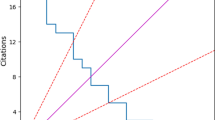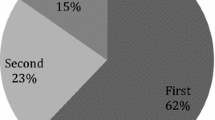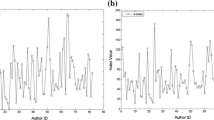Abstract
To be able to measure the scientific output of researchers is an increasingly important task to support research assessment decisions. To do so, we can find several different measures and indices in the literature. Recently, the h-index, introduced by Hirsch in 2005, has got a lot of attention from the scientific community for its good properties to measure the scientific production of researchers. Additionally, several different indicators, for example, the g-index, have been developed to try to improve the possible drawbacks of the h-index. In this paper we present a new index, called hg-index, to characterize the scientific output of researchers which is based on both h-index and g-index to try to keep the advantages of both measures as well as to minimize their disadvantages.


Similar content being viewed by others
References
Ball, P. (2005). Index aims for fair ranking of scientists. Nature, 436(7053), 900.
Bar-Ilan, J. (2008). Which h-index?—a comparison of WoS, Scopus and Google Scholar. Scientometrics, 74(2), 257–271.
Bornmann, L., & Daniel, H.-D. (2007). What do we know about the h index? Journal of the American Society for Information Science and Technology, 58(9), 1381–1385.
Bornmann, L., Mutz, R., & Daniel, H.-D. (2008). Are there better indices for evaluation purposes than the h index? A comparison of nine different variants of the h index using data from biomedicine. Journal of the American Society for Information Science and Technology, 59(5), 830–837.
Braun, T., Glänzel, W., & Schubert, A. (2005). A Hirsch-type index for journals. The Scientist, 19(22), 8.
Burrell, Q. L. (2007).On the h-index, the size of the Hirsch core and Jin’s A-index. Journal of Informetrics, 1(2), 170–177.
Cho, A. (2005). Your career in a number. Science Now, http://www.sciencenow.sciencemag.org/cgi/content/full/2005/812/1. Accessed 26.06.2008.
Costas, R., & Bordons, M. (2007). The h-index: Advantages, limitations and its relation with other bibliometric indicators at the micro level. Journal of Informetrics, 1, 193–203.
Cronin, B., & Meho, L. (2006). Using the h-index to rank influential information scientists. Journal of the American Society for Information Science and Technology, 57(9), 1275–1278.
Egghe, L. (2006a). An improvement of the h-index: The g-index. ISSI Newsletter, 2(1), 8–9.
Egghe, L. (2006b). Theory and practise of the g-index. Scientometrics, 69(1), 131–152.
Egghe, L. (2007). Dynamic h-index: The Hirsch index in function of time. Journal of the American Society for Information Science and Technology, 58(3), 452–454.
Egghe, L., & Rousseau, R. (2006). An informetric model for the Hirsch-index. Scientometrics, 69(1), 121–129.
Hirsch, J. E. (2005). An index to quantify an individual’s scientific research output. In Proceedings of the National Academy of Sciences, 102, 16569–16572.
Iglesias, J. E., & Pecharromán, C. (2007). Scaling the h-index for different scientific ISI fields. Scientometrics, 73, 303–320.
Jin, B. (2007). The AR-index: Complementing the h-index. ISSI Newsletter, 3(1), 6.
Jin, B., Liang, L., Rousseau, R., & Egghe, L. (2007). The R- and AR-indices: Complementing the h-index. Chinese Science Bulletin, 52(6), 855–863.
Levitt, J. M. & Thelwall, M. (2007). Two new indicators derived from the h-index for comparing citation impact: Hirsch frequencies and the normalised Hirsch index. In D. Torres-Salinas & H.F. Moed (Eds.), Proceedings of the 11th Conference of the International Society for Scientometrics and Informetrics (Vol 2, pp. 876–877). Madrid, Spain: Spanish Research Council (CSIC).
Leydesdorff, L. (2008). Caveats for the use of citation indicators in research and journal evaluations. Journal of the American Society for Information Science and Technology, 59(2), 278–287.
Martin, B. R. (1996). The use of multiple indicators in the assessment of basic research. Scientometrics, 36(3), 343–362.
Molinari, A., & Molinari, J. F. (2008). Mathematical aspects of a new criterion for ranking scientific institutions based on the h-index. Scientometrics, 75(2), 339–356.
Oppenheim, C. (2007). Using the h-index to rank infuential British researchers in information science and librarianship. Journal of the American Society for Information Science and Technology, 58(2), 297–306.
Purvis, A. (2006). The h index: playing the numbers game. Trends in Ecology & Evolution, 21(8), 422–422.
Rousseau, R. (2006). New developments related to the Hirsch index. Science Focus, 1(4), 23–25 (in Chinese). English version available at: E-LIS: code 6376, http://www.eprints.rclis.org/archive/00006376/. Accessed 26.06.2008.
Ruane, F., & Tol, R. S. J. (2008). Rational (successive) h-indices: An application to economics in the Republic of Ireland. Scientometrics, 75(2), 395–405.
Sidiropoulos, A., & Katsaros, D., Manolopoulos, Y. (2007). Generalized Hirsch h-index for disclosing latent facts in citation networks. Scientometrics, 72(2), 253–280.
Van Leeuwen, T. N., Visser, M. S., Moed, H. F., Nederhof, T. J., & Van Raan, A. F. J. (2003). The holy grail of science policy: Exploring and combining bibliometric tools in search of scientific excellence. Scientometrics, 57(2), 257–280.
Vanclay, J. K. (2007). On the robustness of the h-Index. Journal of the American Society for Information Science and Technology, 58(10), 1547–1550.
Acknowledgments
This work has been supported by the research projects: FUZZY-LING (TIN2007-61079), SAINFOWEB (P05-TIC-00602) and PETRI project PET2007-0460.
Author information
Authors and Affiliations
Corresponding author
Rights and permissions
About this article
Cite this article
Alonso, S., Cabrerizo, F.J., Herrera-Viedma, E. et al. hg-index: a new index to characterize the scientific output of researchers based on the h- and g-indices. Scientometrics 82, 391–400 (2010). https://doi.org/10.1007/s11192-009-0047-5
Received:
Accepted:
Published:
Issue Date:
DOI: https://doi.org/10.1007/s11192-009-0047-5




